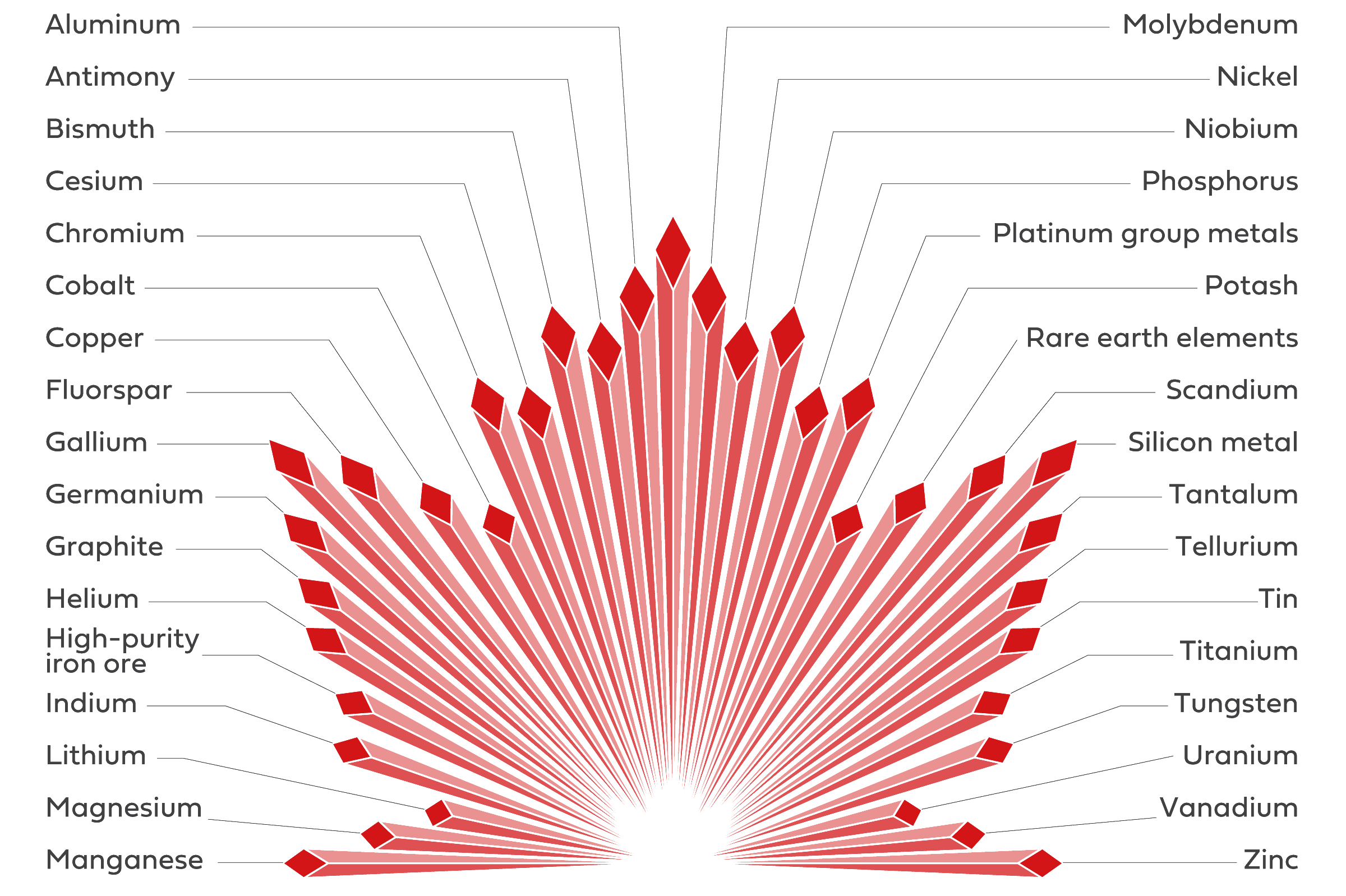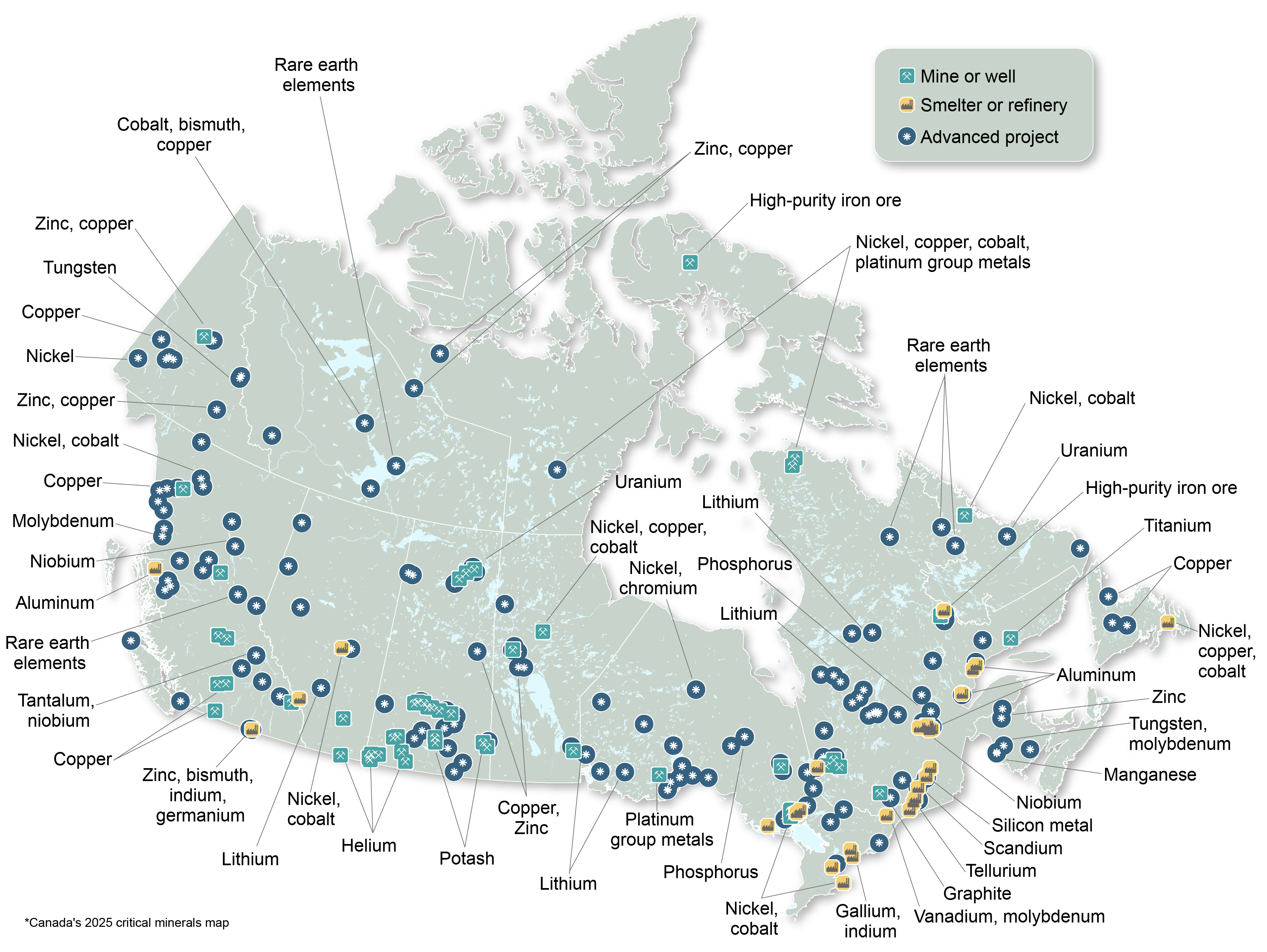Canada’s critical minerals
Critical minerals are the foundation upon which modern technology is built. They are used in a wide range of essential products ranging from mobile phones and solar panels to electric vehicle batteries, medical devices and defence applications. Canada’s critical minerals list identifies 34 minerals and metals.

Text version
List of 34 critical minerals depicted in the shape of a maple leaf. The 34 critical minerals are:
- Aluminum
- Antimony
- Bismuth
- Cesium
- Chromium
- Cobalt
- Copper
- Fluorspar
- Gallium
- Germanium
- Graphite
- Helium
- High-purity iron ore
- Indium
- Lithium
- Magnesium
- Manganese
- Molybdenum
- Nickel
- Niobium
- Phosphorus
- Platinum group metals
- Potash
- Rare earth elements
- Scandium
- Silicon metal
- Tantalum
- Tellurium
- Tin
- Titanium
- Tungsten
- Uranium
- Vanadium
- Zinc
First released in 2021, the list was updated in 2024 in consultation with provinces and territories; as well as exploration, mining and manufacturing industries and associations; and Indigenous organizations and communities. New to the list in 2024 are three minerals:
- High-purity iron ore — Essential to green steel making and decarbonization
- Phosphorus — Essential for batteries and food security
- Silicon metal — Essential for semiconductors and computer chips
What makes them critical
To be considered a critical mineral in Canada, a mineral must meet both of the following criteria:
- the supply chain is threatened
- there is a reasonable chance of the mineral being produced by Canada
It must also meet one of the following criteria:
- be essential to Canada’s economic or national security
- be required for the national transition to a sustainable low-carbon and digital economy
- position Canada as a sustainable and strategic partner within global supply chains
Our future depends on critical minerals
Critical minerals are the building blocks for the green and digital economy as they are used in products such as:
- Wind turbines and solar panels
- Electric vehicles and charging stations
- Drones and satellites
- Smartphones and laptops
- Data centres and mobile networks
Canada’s critical minerals list supports three priority value chains outlined in the Canadian Critical Minerals Strategy:
Advanced manufacturing
- Defence applications
- Advanced materials
- High value-added metals
Clean technologies
- Batteries and zero-emission vehicles
- Renewable energy generation and transmission
- Permanent magnets
Information and communications technologies
- Compound semiconductors
- Telecommunications
Critical minerals value chain
A value chain represents a series of consecutive steps that go into the creation of a finished product. For critical minerals, the value chain includes five segments as seen in the graphic below: geoscience and exploration, mineral extraction, intermediate processing, advanced manufacturing, and recycling.

Text version
Graphic of critical minerals value chain showing: 1) upstream processes (geoscience & exploration, and mineral extraction), 2) midstream processes (intermediate processing and advanced manufacturing), and 3) downstream processes (assembly & end use products). Downstream processes feed into recycling processes, which support advanced manufacturing.
Canada can play a role in many value chains that are essential to the manufacturing of products for a digital and green economy (e.g., cell phones and electric vehicles). These include:
Critical mineral development across Canada
Critical mineral mines, smelters, refineries or advanced projects are located in all Canadian provinces and territories, except for Prince Edward Island.

Text version
- Alberta has advanced projects and smelters or refineries that are labelled as lithium, nickel, cobalt and titanium.
- British Columbia has advanced projects, smelters or refineries, and mines that are labelled as molybdenum, niobium, aluminum, copper, zinc, bismuth, indium and germanium.
- Manitoba has advanced projects and mines that are labelled as nickel, copper and cobalt.
- New Brunswick has advanced projects that are labelled as tungsten and molybdenum.
- Newfoundland and Labrador has advanced projects, mines, and smelters or refineries that are labelled as rare earth elements, nickel, cobalt and high-purity iron ore.
- The Northwest Territories has advanced projects that are labelled as rare earth elements, cobalt, bismuth, and copper.
- Nova Scotia has advanced projects that are labelled as tin, copper and zinc.
- Nunavut has advanced projects that are labelled as copper, nickel, cobalt, and platinum group metals.
- Ontario has advanced projects, mines, and smelters or refineries that are labelled as chromium, graphite, nickel, cobalt, and platinum group metals.
- Quebec has advanced projects, mines, and smelters or refineries that are labelled as lithium, magnesium, rare earth elements, graphite, nickel, cobalt, platinum group metals, vanadium, molybdenum, niobium, silicon-metal, phosphorus, scandium and aluminum.
- Saskatchewan has advanced projects and mines that are labelled as uranium, potash and helium.
- Yukon has advanced projects and mines that are labelled as zinc, copper and tungsten.
Connect with us
Have questions or comments? Contact the Critical Minerals Centre of Excellence.
Stay informed with the latest news on funding opportunities, Canada’s critical minerals strategy, and more. Sign up for our newsletter.